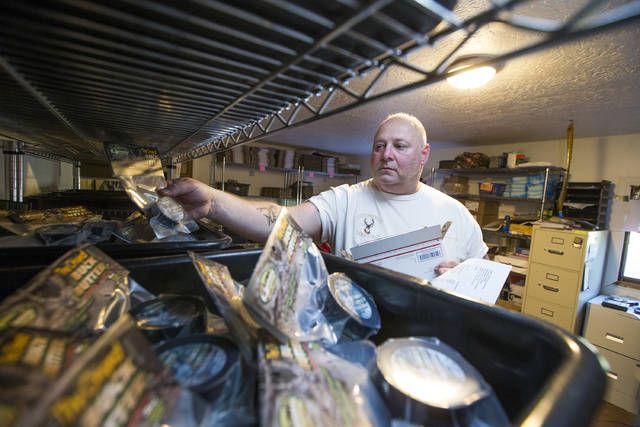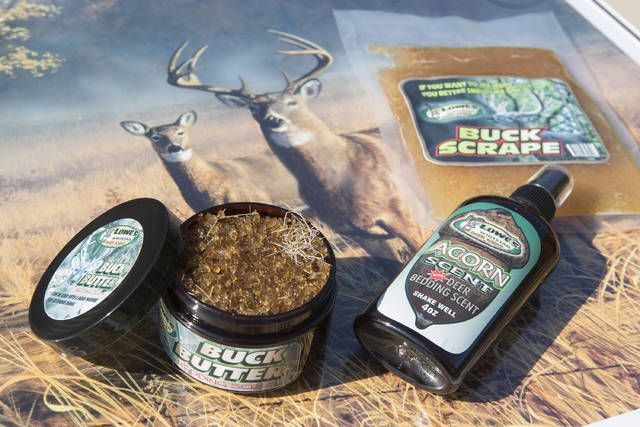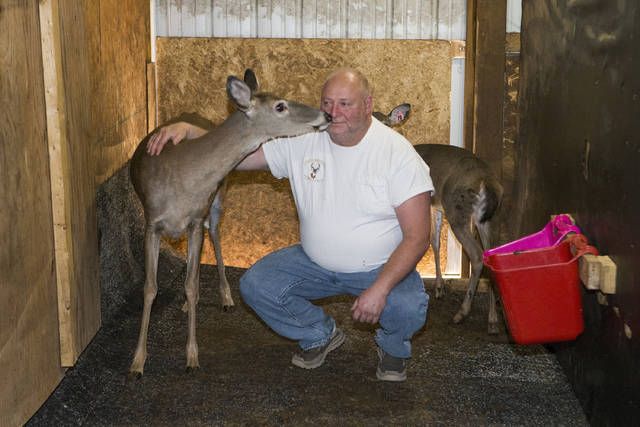Click here to subscribe today or Login.
LANDISBURG, Pa. (AP) — It was harvest time at Rick Lowe’s split-level home in rural Perry County, and the flypaper above his living room couch swung heavy with the dead.
Down some stairs, behind wooden doors, the pungent laboratory where Lowe practices his reverse alchemy was full of needles and a blowgun and glass jars brimming with things few folks would dare jar.
Bottles of amber liquid on the shelves looked like apple cider, but the nose doesn’t lie.
It was urine, gallons and gallons of whitetail deer urine, waiting to be shipped out and spread across the wilds of America.
“My stuff is fresh,” Lowe, 54, said in his Lowe’s Whitetail lab last week. “I use about a gallon of it myself.”
Deer urine has been used for decades by hunters in states where it’s legal to mask human scent and draw large bucks with nice racks into range. They can sprinkle it on clothes, hang something akin to a urine-soaked air freshener from branches, or open a tin of crystallized urine beneath hunting stands. There’s a handful of producers in Pennsylvania like Lowe, each a bit secretive with guarded recipes, farmers of sorts who’ve managed to turn waste into extra income or a full-time business.
“I owned 19 acres of all woods, so I couldn’t get in any other industry, like beef and pork,” said Paul Carson, owner of West Wind Whitetails & Scents in Erie County. “I fenced in a couple of acres and bought a couple of deer. That was in in 1985. I am one of the pioneers in Pennsylvania.”
Collecting urine isn’t as simple as dropping a bucket under a deer’s rear end. They’re skittish animals, even those bottle-fed as fawns. Bucks, particularly during the fall mating season, can be ornery.
“We cut their antlers off so they can’t kill anyone,” said Elam Lapp Jr., whose Nationwide Scents in Millersburg, Dauphin County is one of the nation’s biggest producers of pee.
Lapp, 28, is Amish, and his family has been farming in Pennsylvania for generations. First, it was dairy cows. Eventually, the Lapps became deer farmers, raising trophy bucks for breeding stock and private hunting ranches, which also operate in the state, before settling on urine.
“Amish culture is farming,” Lapp said last week. But “it’s just not very viable in this day and age for a small mom-and-pop operation.”
Lapp’s operation doesn’t feel mom-and-pop. Hundreds of deer live on more than 200 acres in two locations. They are moved indoors for collection for a few hours, into a 5,000-square-foot facility with raised stalls resembling giant rabbit hutches. They’re given food and water; fans whirl loudly for ventilation.
“They’ll pee six to eight ounces per sitting, about a half-gallon a day, all year,” Lapp said.
The urine funnels down through filters and basic plumbing into the basement, where the sheer volume boggles the mind.
“They’re 55-gallon drums,” Lapp said, pointing to rows of white drums.
He sells most of his product to companies that relabel it as their own, but he has a special batch he freezes and ships direct to customers.
The majority of deer urine comes from does, the female deer, but there are variations. The most valuable is from does in estrus, because they produce more estrogen and draw in bucks ready to mate. Some urine farmers can bring their does into estrus artificially.
Buck urine could attract a male looking to fight.
“I start collecting in the summer and I sell a lot of regular doe pee,” Carson said. “I can sell a gallon of doe in estrus for $105 to $110. Dominant buck pee can go for about $60.”
Urine-industry statistics are murky because producers are lumped together under deer farming, which includes raising trophy deer and deer for venison. There are approximately 1,000 deer-farming families in Pennsylvania, according to the state’s Deer Farmers Association — the second most after Texas. A small percentage deal in urine, and of those, Lapp’s operation is the biggest in the country, the group said.
A recent New Yorker article said deer urine was a “hundred-million-dollar business.” A CNN report from 2008 put it at $44 million. Overall, hunters nationwide spend tens of billions on gear each year.
One problem that has complicated the urine business is chronic wasting disease, a fatal, mad cow-like disease that affects the cervid family: deer, elk, and moose. It was first noticed in captive mule deer in Colorado in the 1960s and has spread eastward, including into parts of Pennsylvania. According to the Chronic Wasting Disease Alliance, cases of CWD have been found in Blair and Bedford Counties.
Because urine is one of the ways CWD can spread, some states, including Virginia and Vermont, have banned its use in hunting. Lapp was recently featured in a New Yorker article on the subject, as New York state is contemplating following suit.
Further bans could impact a way of life he’s trying to hold on to, Lapp said on his farm last week.
“The science isn’t there at this point. It’s just not there.”
Nicholas Haley, an assistant professor of microbiology at Midwestern University in Arizona, has studied CWD for a decade. Of all the liquids and body parts on a deer, Haley said urine has the lowest levels of “infectivity” and believes regulatory agencies have targeted it for the wrong reasons.
“Urine kind of represents this low-hanging fruit,” he said. “It’s easy to regulate, and it makes it look like you’re doing something to prevent the spread of CWD.”
In Pennsylvania, deer farming comes under the purview of the state Department of Agriculture, which requires farmers to take part in one of two CWD monitoring programs. The Pennsylvania Game Commission prohibits the use of deer urine in the state’s two disease-management zones in south central and north central parts of the state. Elsewhere, it’s legal to use for hunting.
Lowe has been in the deer-scent business for 25 years with his wife, Anita, and said he understands the concerns about CWD. That’s why he has branched off into other areas, above and beyond mere urine, to attract deer and mask smelly humans.
Some of his cover scents smell like acorn or hardwoods; one called “Dirth” is a “dirt and earth combo.” He is experimenting with synthetics, but he also learned to make deer “lures” from a legendary New York trapper named Johnny Thorpe.
There are glands in those glass jars, among other things.
“He taught me to take the testicles, then you cut them and tincture them,” Lowe said. “Then you add some stuff, then you have to roll it, and then you add enhancer. It actually gets better with age.”
Neither Carson, a retired boilermaker, nor Lowe, who works for SYGMA Foods in Harrisburg, are big enough to farm urine full-time.
The most difficult aspect, Carson said, is dispensing it into the four-ounce bottles. Urine is not plutonium, but still.
“I can’t have a radio playing in the garage when I’m doing this,” he said. “Nobody can talk to me.”
Lowe said he’d like to branch out eventually or at least add a separate building for his urine and tincture lines so he doesn’t have to mix it all in the house.
“I’m very secretive about my operation,” he said. “It’s taken me years. A lot of guys want to know how I make my stuff. I don’t want to give enough information to be dangerous. I’ve had guys want to come out and take tours, and I just can’t do it.”
___
Online:
http://bit.ly/2yfQq2O
___
Information from: The Philadelphia Inquirer, http://www.inquirer.com







